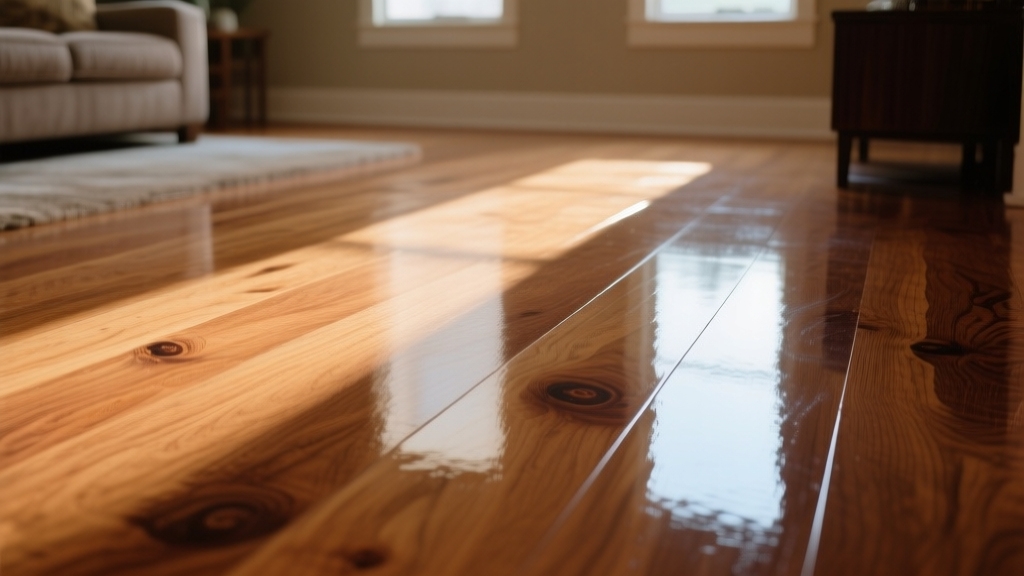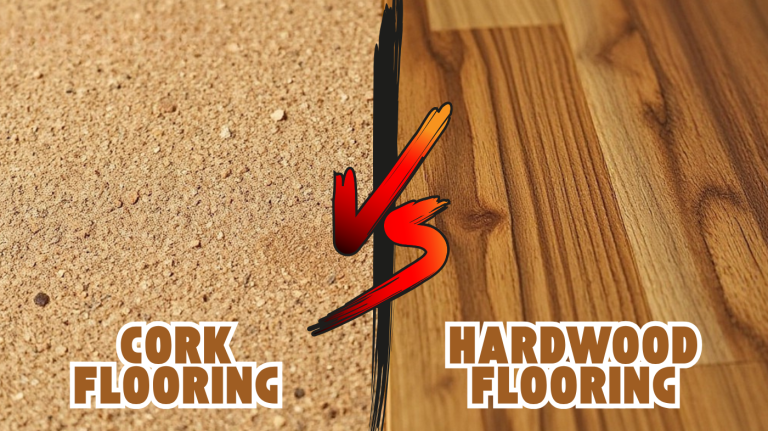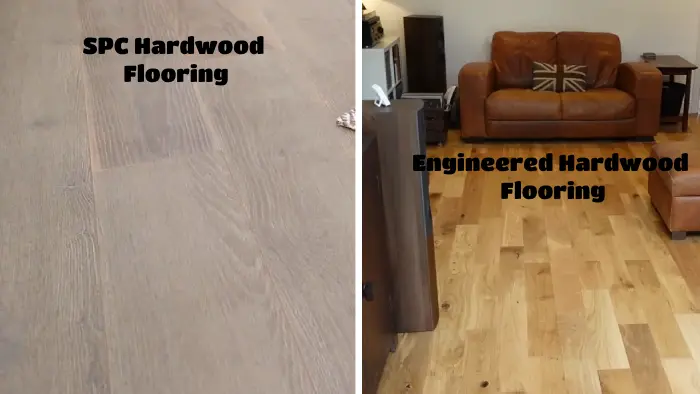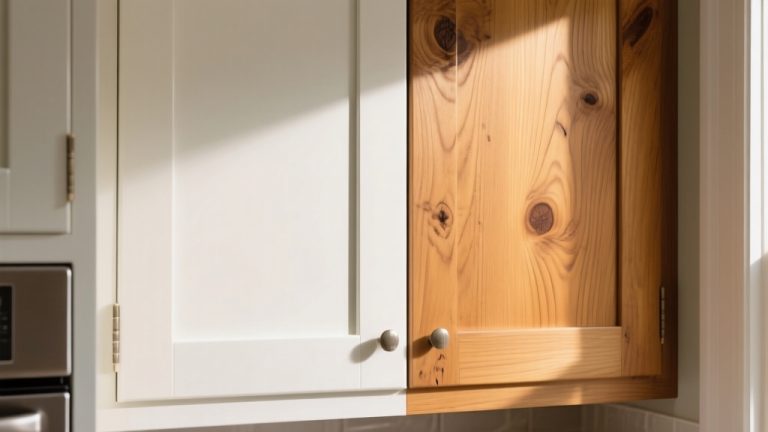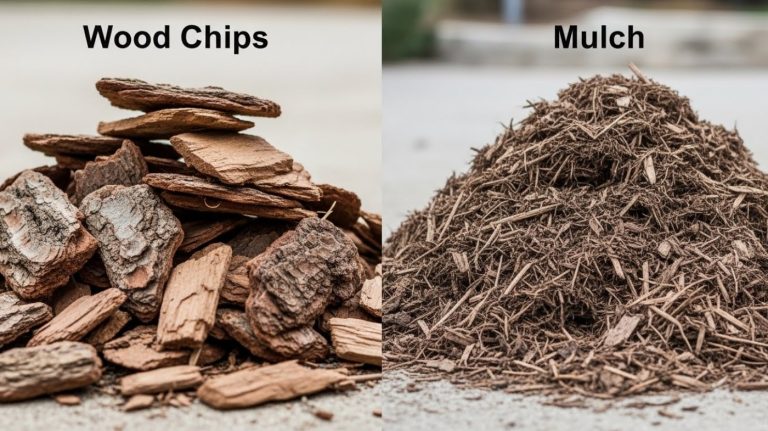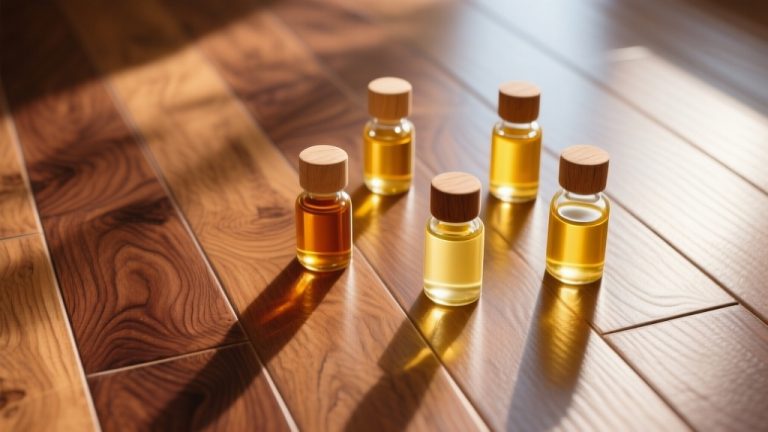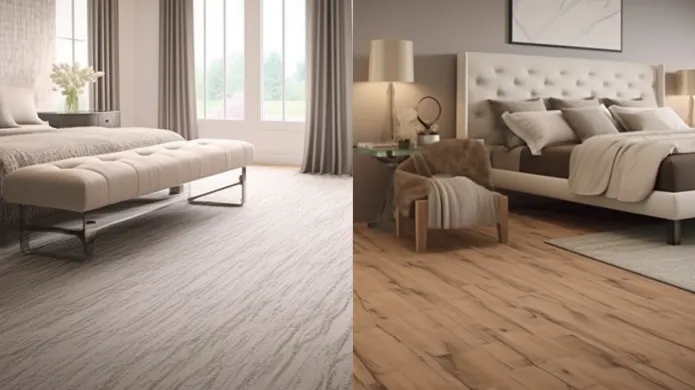Semi Gloss vs High Gloss Hardwood Floors: Best Choice
If you want a hardwood floor that balances subtle shine with practicality, semi-gloss offers a soft luster that beautifully highlights wood tones while concealing scratches and dust. This finish is perfect for busy living spaces.
High gloss creates a stunning, mirror-like finish that amplifies light and room size but demands meticulous upkeep to keep imperfections invisible. Your choice affects not just appearance but ambiance, maintenance, and safety.
Explore how each finish transforms your space and fits your lifestyle.
Key Takeaways
- High gloss floors reflect over 80% light, creating a dramatic, mirror-like finish that highlights wood grain and brightens rooms.
- Semi-gloss floors offer a softer shine (25–35% reflection), balancing elegance with practicality by concealing minor scratches and dust.
- High gloss surfaces magnify imperfections and require frequent cleaning and polishing to maintain their pristine look.
- Semi-gloss flooring tolerates moderate maintenance, hiding flaws better and providing a subtle glow suitable for busy living spaces.
- High gloss enhances formal, low-traffic areas with bold ambiance, while semi-gloss suits versatile, moderate-traffic environments prioritizing durability and safety.
High Gloss vs Semi Gloss Hardwood Floors: Quick Comparison
| Feature | Semi Gloss | High Gloss |
|---|---|---|
| Light Reflection | 45-65% moderate shine | 70-90% mirror-like finish |
| Maintenance Level | Low to moderate upkeep | High maintenance required |
| Imperfection Visibility | Conceals minor flaws well | Highlights every scratch |
| Best Room Types | Living rooms, bedrooms, high-traffic areas | Formal spaces, commercial settings |
| Slip Resistance | Better traction, safer when wet | More slippery, especially when wet |
| Cleaning Frequency | Every 2-3 days acceptable | Daily cleaning recommended |
| Cost | More affordable installation | Higher cost due to complex application |
| Durability | 7-10 years before refinishing | 7-10 years with proper care |
| Visual Impact | Subtle elegance, warm ambiance | Dramatic luxury, formal atmosphere |
| Refinishing Difficulty | Moderate complexity | Complex, requires professional care |
Understanding Sheen and Luster in Hardwood Flooring
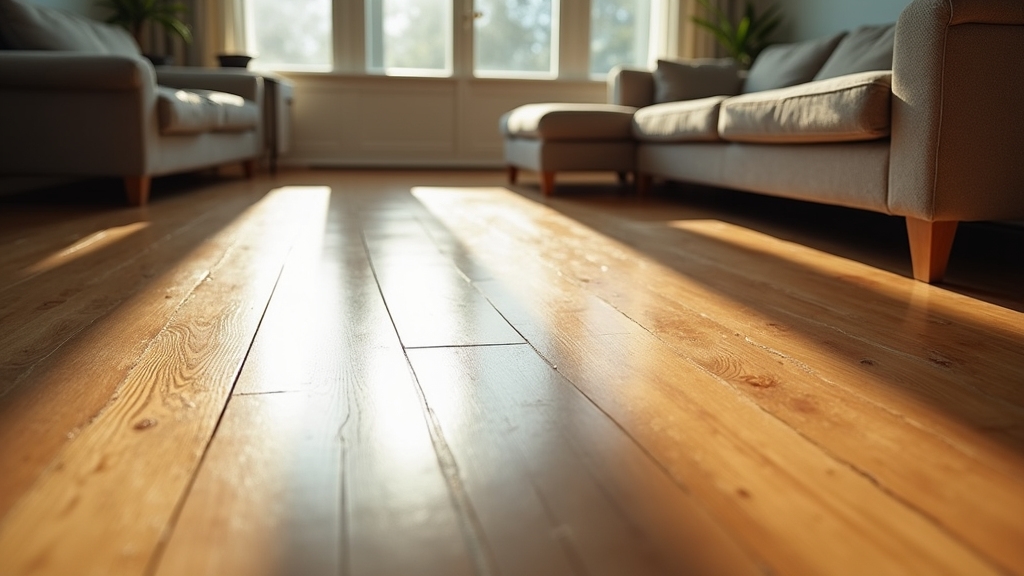
Sheen, the measure of light reflection, directly controls your floor’s luster and overall appearance.
Using a gloss meter at a 60-degree angle, sheen is quantified in percentages: matte floors reflect 0–10% light, satin 25–35%, semi-gloss 55–65%, and high gloss over 80%. This scale helps you visualize how much shine your floor will have without relying on finish type, since polyurethane, oil-based, or water-based finishes can all achieve various levels.
Different finishes can be formulated to achieve various sheen levels, so selecting the right product is crucial for your desired sheen level. Regular maintenance methods such as vacuuming hardwood floors can help preserve the finish and luster over time.
Choosing the right sheen balances aesthetics and practicality. Lower sheens highlight wood’s natural texture and hide imperfections, while higher sheens create dramatic reflections but reveal flaws more easily.
Visual and Aesthetic Differences Between Semi-Gloss and High-Gloss
You’ll notice that high gloss floors really reflect light intensely. They create this dramatic, mirror-like sheen that can elevate a room’s sophistication.
On the other hand, semi-gloss offers a softer, balanced glow. It complements various styles without overwhelming the space. Semi-gloss finishes typically have around 70% luster, providing a high shine that enhances natural woodgrain.
Now, one thing to keep in mind is that high gloss finishes highlight every little imperfection. This means they demand meticulous upkeep.
In contrast, semi-gloss does a better job of concealing minor flaws, which makes it a more practical choice for busy spaces.
So, when it comes down to it, your choice really depends on what vibe you’re going for. Do you want a bold, formal statement with high gloss? Or are you leaning towards a refined, versatile ambiance with semi-gloss?
Sheen and Reflection
Although both semi-gloss and high gloss hardwood floors enhance your space, they differ markedly in sheen and reflection, shaping the room’s atmosphere.
Semi-gloss offers a moderate sheen with 45-55% luster, reflecting light gently to create a smooth, lustrous look without overwhelming glare.
It balances shine and subtlety, making it versatile under various lighting conditions while concealing minor imperfections and wear. This finish provides a refined look, balancing elegance with subtlety, and enhances wood’s natural beauty, similar to a satin finish.
High gloss, with around 70% luster, produces a mirror-like surface that dramatically intensifies light reflection, accentuating wood grain and brightening the room considerably. However, it also highlights dust, footprints, and flaws more easily. High gloss finishes are rarely used in residential settings due to their high maintenance needs.
Choosing between these finishes means weighing the semi-gloss’s forgiving, practical reflection against the high gloss’s striking, high-shine brilliance tailored for more formal or commercial environments.
Style and Ambiance
When selecting between semi-gloss and high-gloss hardwood floors, consider how each finish shapes your room’s style and ambiance. High-gloss floors create a dramatic, luxurious aura, perfect for formal spaces. They reflect light to visually expand your room and emphasize wood grain with a brighter, reflective surface.
Semi-gloss offers a sophisticated, less intense shine, ideal for both formal and casual settings. It balances elegance with subtlety. High-gloss enhances wood color depth and brightens naturally lit rooms. Semi-gloss highlights warm wood tones and suits moderate lighting. It also tends to be better at hiding imperfections than high gloss.
Semi-gloss fits casual and modern aesthetics better than high-gloss. High-gloss floors demand more upkeep in sunny rooms due to glare. Choosing between these finishes lets you tailor your space’s mood, from bold and elegant to refined and inviting.
Imperfection Visibility
Because the level of gloss directly influences how light interacts with your hardwood floor, imperfection visibility varies markedly between semi-gloss and high-gloss finishes.
Semi-gloss, with its moderate 45-75% sheen, diffuses light softly, concealing scratches, dust, and dents more effectively. This finish balances shine and subtlety, making imperfections less intrusive and ideal for moderate-traffic areas. Using a pH-neutral cleaner regularly helps maintain the finish without dulling the surface.
In contrast, high gloss floors reflect 70-90% light, creating a mirror-like surface that highlights every scratch, footprint, and smudge. While high gloss enhances brightness and elegance, it demands rigorous maintenance to avoid emphasizing wear. Its high durability makes it a robust choice for areas needing extra protection.
If you want a polished look that’s forgiving of everyday flaws, semi-gloss is your best choice. High gloss suits formal or low-traffic spaces where pristine upkeep is feasible but can accentuate imperfections in busy environments.
Maintenance Requirements for Semi Gloss vs High Gloss Floors
Hey there! So, when it comes to high gloss floors, you’ll find they really need some extra attention. Why’s that? Well, their shiny surface tends to show off every little scratch and smudge, which means more frequent cleaning. Using soft-bristled tools can help prevent damage while maintaining that polished look.
On the flip side, semi gloss finishes do a better job of hiding imperfections. This means you won’t have to clean them as often, which is pretty convenient, right? Semi-gloss finishes also offer a good balance of durability and aesthetic appeal, making them a practical choice for many homes.
Now, both types of finishes still need some careful polishing to keep them looking their best. But here’s the thing: high gloss floors usually require a bit more intense refinishing to keep them from getting dull over time.
It’s all about choosing the right maintenance routine so you can keep your hardwood floors looking elegant and beautiful for years to come!
Cleaning Frequency Comparison
Although both semi-gloss and high gloss hardwood floors require regular care, their cleaning frequency differs markedly due to how each finish reveals dust, dirt, and smudges.
High gloss floors demand more frequent cleaning as their reflective surface highlights every particle, while semi-gloss floors disperse light, masking dust better and allowing longer intervals between cleanings. Using microfiber mops properly wrung out helps avoid streaks and over-saturation on both finishes.
To maintain your floors’ aesthetic appeal, consider these points:
- High gloss requires daily or near-daily sweeping and damp mopping to preserve its mirror-like shine.
- Semi-gloss allows you to extend cleaning intervals by a day or two without losing its polished look.
- Both finishes benefit from hardwood-safe cleaners and gentle vacuuming to avoid damage.
- High traffic and pets increase cleaning needs, especially for high gloss surfaces.
Understanding these nuances helps you balance upkeep with lasting beauty. It is important to use pH-neutral, residue-free cleaners to prevent buildup and streaking on both finishes.
Scratch and Imperfection Visibility
When choosing between semi-gloss and high-gloss hardwood floors, understanding how each finish reveals scratches and imperfections is essential to maintaining their beauty.
Semi-gloss floors offer a balanced sheen of 40–55 degrees, reflecting light softly and masking minor flaws better than high gloss. You’ll notice scratches and dents, but they won’t jump out sharply. This level of sheen balances shine and practicality, making it suitable for those seeking a polished look with moderate maintenance.
Additionally, environmental factors such as humidity levels can influence how dirt and imperfections settle on the floor surface.
In contrast, high-gloss floors possess an intense, mirror-like reflection above 80 degrees, which magnifies every scuff, dust particle, and surface irregularity. This makes high-gloss finishes less forgiving, demanding extra care to keep marks invisible.
While semi-gloss provides a sophisticated shine with moderate maintenance, high-gloss floors require diligent upkeep to preserve their pristine look, especially under harsh lighting that accentuates every imperfection.
Polishing and Refinishing Needs
Because maintaining the flawless appearance of hardwood floors hinges on their finish, understanding the distinct polishing and refinishing needs of semi-gloss versus high-gloss surfaces is essential.
High-gloss floors demand more frequent polishing with specialized products to preserve their mirror-like shine, often requiring professional care. Semi-gloss finishes tolerate less frequent maintenance, allowing homeowners to manage upkeep more easily, but both finishes benefit from applying protective coatings to extend their lifespan.
Refinishing high-gloss floors involves multiple thin coats and longer curing times, while semi-gloss refinishing is somewhat less intensive. Water-based polyurethane finishes, which are popular for their fast-drying properties, can help reduce overall maintenance time. Consider these key maintenance points:
- High gloss needs frequent, professional polishing and occasional buffering.
- Semi-gloss requires fewer coats during refinishing and faster curing.
- Specialized cleaning products protect high-gloss floors’ delicate surface.
- Both finishes benefit from regular sweeping, vacuuming, and tack cloth use during refinishing.
Practical Applications and Ideal Settings for Each Finish
While choosing between semi-gloss and high gloss hardwood finishes, you’ll want to contemplate how each finish performs in different environments and the visual impact they create.
Consider both performance and appearance when selecting between semi-gloss and high gloss hardwood finishes.
Semi-gloss offers versatility, balancing shine with durability, making it ideal for dining rooms, bedrooms, living areas, and moderate-traffic hallways. Its subtle reflection conceals minor imperfections and suits both traditional and modern interiors, requiring less upkeep than high gloss.
Additionally, semi-gloss finishes are popular across many hardwood brands and wood species, including exotic and domestic types, which adds to their widespread appeal and usability popularity across species. Using proper cleaning methods, such as controlled moisture application, can help maintain semi-gloss floors’ appearance over time.
On the other hand, high gloss delivers a striking, mirror-like sheen perfect for commercial spaces, formal rooms, and display areas where luxury and brightness matter. However, it demands rigorous maintenance and may pose slip risks in busy areas.
Impact on Room Lighting and Ambiance
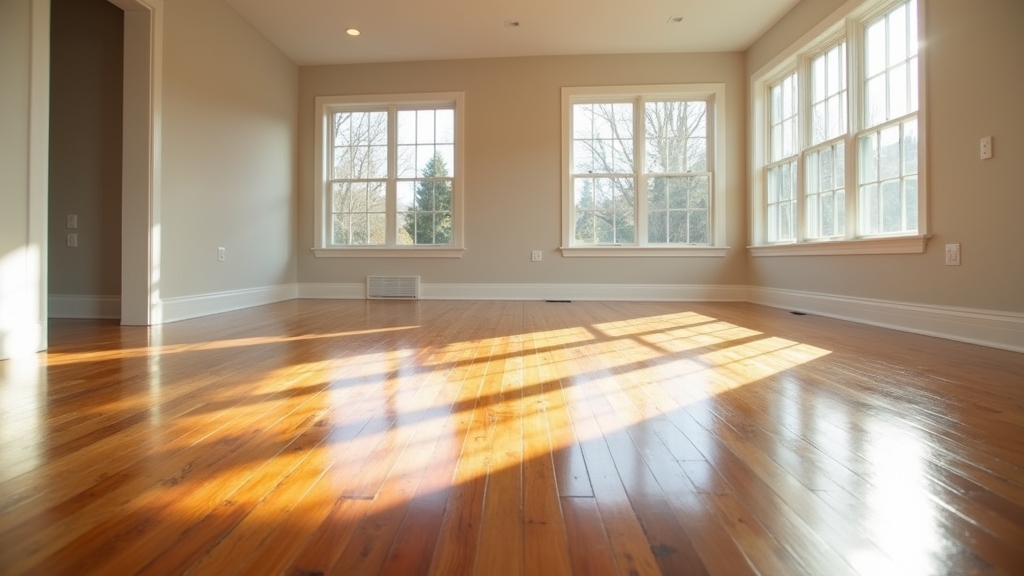
Although both semi-gloss and high gloss hardwood finishes enhance room lighting, their impact on ambiance varies markedly.
High gloss floors reflect up to 90% of light, flooding your space with brightness and creating a formal, luxurious atmosphere. This level of sheen can also make imperfections more noticeable, requiring more frequent maintenance to preserve its pristine look. Using proper floor care techniques can help maintain the high gloss finish over time.
In contrast, semi-gloss reflects about half as much light, offering a polished look that balances warmth and subtlety. Additionally, semi-gloss finishes conceal imperfections better, making them more forgiving in high-traffic areas.
Choosing between them shapes your room’s feel and lighting dynamics significantly. Consider these effects when deciding:
- High gloss amplifies light, making rooms feel larger and more open.
- Semi-gloss softens reflections, promoting a cozy, inviting mood.
- High gloss highlights wood grain dramatically but demands upkeep.
- Semi-gloss conceals imperfections better, maintaining a cleaner appearance longer.
Your choice directly influences both the lighting quality and the emotional tone of your space.
Safety and Slip Resistance Considerations
When selecting between semi-gloss and high gloss hardwood floors, understanding their slip resistance is vital for ensuring safety.
Semi-gloss finishes offer moderate sheen with less reflectivity, creating a surface that’s less slippery, especially when wet. Their tighter surface films also resist moisture buildup, enhancing traction.
In contrast, high gloss floors feature a mirror-like smoothness that can reduce grip and increase slip risks, particularly in moist or high-traffic areas.
Additionally, high gloss’s intense glare may obscure wet spots, while semi-gloss allows clearer visibility of surface conditions without excessive reflection.
Regular maintenance is essential for both, but you’ll need to clean high gloss floors more frequently to maintain safety. Choosing semi-gloss balances elegance with practicality, making it ideal where slip resistance matters without sacrificing style.
Frequently Asked Questions
How Does Cost Compare Between Semi Gloss and High Gloss Hardwood Floors?
You’ll find high-gloss hardwood floors usually cost more than semi-gloss, mainly due to the extra labor and premium finishes needed to achieve that mirror-like shine.
While the base wood price stays similar, expect higher installation costs since high-gloss demands meticulous prep and multiple coats.
Maintenance expenses also rise, as you’ll clean and refinish high-gloss floors more frequently to keep their dazzling look. Semi-gloss offers a cost-effective, elegant alternative with easier upkeep.
Can Semi Gloss or High Gloss Finishes Be Applied Over Existing Floor Finishes?
You might think you have to strip your floors completely, but yes, you can apply semi-gloss or high-gloss finishes over existing ones if you prep carefully.
Clean thoroughly, lightly sand to remove shine, and verify compatibility between old and new finishes. Remember, high-gloss highlights imperfections, so flawless prep is key.
Test a spot first, and maintain with gentle cleaning and periodic buffing to keep that luminous, showroom-quality gleam.
What Types of Wood Species Work Best With Semi Gloss or High Gloss Finishes?
You’ll find oak and hickory excel with semi-gloss, highlighting grain and texture without overwhelming their warmth.
Maple and walnut also shine beautifully in semi-gloss, offering a balanced luster that enhances natural features.
For high-gloss, maple and exotic species like Brazilian cherry create a sleek, dramatic look but require more upkeep.
Keep in mind, softer woods like pine rarely suit these finishes due to visible wear and maintenance challenges.
How Long Does Each Finish Typically Last Before Needing Refinishing?
You can expect both semi-gloss and high-gloss hardwood finishes to last around 7 to 10 years before refinishing becomes necessary.
High-gloss finishes tend to resist wear a bit longer due to their harder surface but show scratches more vividly.
Semi-gloss masks minor imperfections better yet may need refinishing slightly sooner in heavy-traffic zones. Proper maintenance and careful use will help you extend their elegant, protective shine.
Are There Eco-Friendly or Low-Voc Options for Semi Gloss and High Gloss Finishes?
Imagine you’re renovating a living room and want a glossy hardwood floor that’s eco-friendly.
You’ll find water-based polyurethanes offering low- or zero-VOC semi-gloss and high-gloss finishes that dry quickly and resist yellowing.
For example, Vermont Natural Coatings’ PolyWhey delivers durability and a clear sheen while reducing indoor air pollution.
These finishes blend beauty with sustainability, letting you enjoy elegant floors without compromising your health or the environment.
Transform Your Flooring Space: Choose the Perfect Hardwood Finish
When choosing between semi-gloss and high-gloss hardwood floors, remember: beauty is in the eye of the beholder. Semi-gloss offers subtle elegance with easier maintenance and better slip resistance, while high gloss dazzles with a mirror-like shine that amplifies light but demands more care.
Consider your space’s lighting, usage, and safety needs carefully. With the right choice, you’ll elevate your room’s ambiance and create a lasting impression that’s both stunning and practical.

